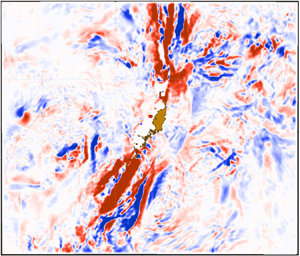Published online by Cambridge University Press: 10 June 2021

We consider the interactions of internal tides (ITs) with a dynamic, rotational and heterogeneous ocean, and spatially varying topography. The IT fields are expanded using vertical modal basis functions, whose amplitudes vary horizontally and temporally. We obtain the evolution equations of modal amplitudes and energy including simultaneous three-way interactions with the mean flow, buoyancy and topography. We apply these equations to a set of idealized and two realistic data-assimilative primitive equation simulations. These simulations reveal that significant interactions of ITs with the background fields occur at topographic features and strong currents, in particular when the scales of the background and ITs are similar. In local hot spots, the new three-way interaction terms, when compared to the total modal conversion, are found to reach up to 10 %–30 % at steep topography and approximately 50 % in the Gulf Stream. We provide a dimensional analysis to guide the diagnosis of such strong interactions. When IT interactions are with a large-scale barotropic current (without topographic effects), our modal energy equation reduces to the conservation of modal wave action under a Wentzel–Kramers–Brillouin consideration. We further derive analytical solutions of the modulation of wavenumber and energy of an IT propagating into a collinear current. For ITs propagating along the flow direction, the wavelength is stretched and the amplitude is reduced, with the degree of modulation determined by  $|\,f/\omega _0|$, the ratio of inertial to tidal frequencies. For ITs propagating opposite to the flow direction, a critical value of
$|\,f/\omega _0|$, the ratio of inertial to tidal frequencies. For ITs propagating opposite to the flow direction, a critical value of  $|\,f/\omega _0|$ exists, below and above which the waves show remarkably different behaviours. The critical opposing current speed which triggers the wave focusing/blocking phenomenon is obtained and its implication for the propagation and dissipation of ITs is discussed.
$|\,f/\omega _0|$ exists, below and above which the waves show remarkably different behaviours. The critical opposing current speed which triggers the wave focusing/blocking phenomenon is obtained and its implication for the propagation and dissipation of ITs is discussed.